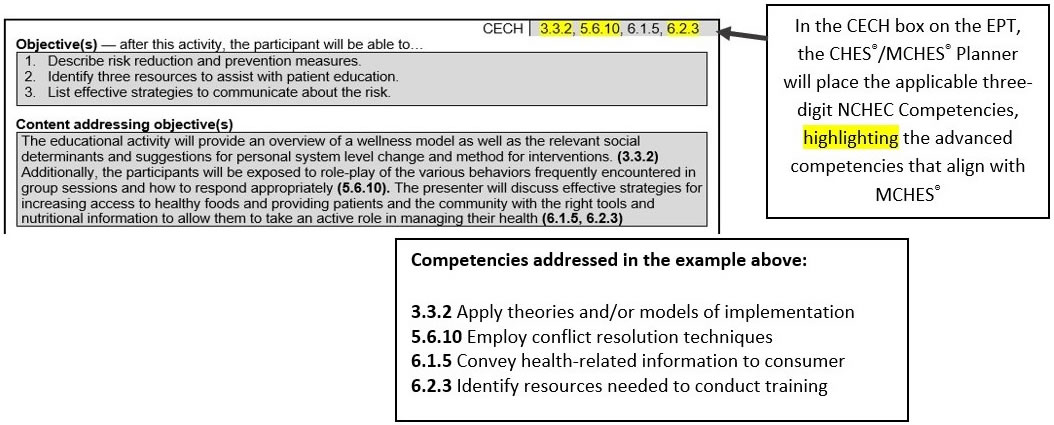Roles and Responsibilities of Planning Committee Members
When seeking accreditation for an educational activity, the CE developer must identify a group of experts that represent the activity’s target audience. This planning committee will help design and implement the educational activity and must include a representative for each type of CE to be offered.
The roles and responsibilities of specific planning committee members are outlined below. We encourage you to review and share this information with members of your planning committee.
Role of Continuing Education (CE) Developer
The Continuing Education (CE) Developer coordinates with the CE Consultant and CE Team to ensure all continuing education proposal documents are completed accurately and meet accreditation requirements.
CE Developer Characteristics
The CE Developer should have:
- Strong organizational and detail-oriented skills
- Good communication and relational skills
- Background or experience in Education
- Dedicated time to complete CE process
- Support of leadership to complete CE process
The CE Developer should have knowledge of:
- Content of the educational activity and purpose of the course
- Adult learning principles
- Educational principles:
- Assessing training needs
- Analyzing gaps in knowledge, skill, or practice
- Writing SMART learning objectives
- Writing goal statements
- Planning and implementing learning activities
- Evaluating outcomes
Primary Responsibilities of the CE Developer
- Serve as the point of contact between the organization/group requesting CE and the CDC CE Consultant.
- Ensure leadership provides the CE developer with the time needed to complete the CE process.
- Attend a CE Orientation with the CE Consultant and other appropriate CE team members (Skype or in person).
- Establish a planning committee that includes CDC representatives for each type of CE requested.
- Maintain access to all confirmed planners and presenters in order to get documents required from each member.
- Provide completed CE proposal documents, as required.
- Meet specified deadlines (date and time) for CE document submissions, as shown on the CE Responsibilities Agreement and Timeline.
- Defer to the CDC CE Consultant to clarify issues or uncertainties with the CE proposal documents.
- Notify the CDC CE Consultant of any changes in the CE process or activity title, date, or time.
- Work with the Training and Continuing Education Online (TCEO) course manager to ensure CE activity is accurately listed in the TCEO system.
Role of Nurse Planner
The nurse planner is essential to fulfill Continuing Nursing Education (CNE) requests.
Nurse Planner Characteristics
The nurse planner should be
- a registered nurse with an active license
- familiar with adult learning principles and theory
- familiar with the American Nurse Credentialing Center (ANCC) and Joint Accreditation continuing education (CE) requirements
Primary Responsibilities of the Nurse Planner
- Serve as an active member of the planning committee, providing relevant insight on educational needs, intended audience, and learning assessments for each CNE activity.
- Assure educational activities are planned according to current ANCC criteria, policies, and procedures, and are appropriate for nurses, including the following
- identifying and addressing a professional practice gap
- identifying one or more learning outcomes that can be achieved by learners participating in the educational activity
- using strategies to engage the learners in the educational activity
- ensuring content is based on the most current evidence (may include, but is not limited to evidence-based practice, literature review, clinical guidelines, best practices)
- confirming that learning outcomes are evaluated appropriately
- planning independently, without influence of commercial interest organizations
- Complete the Nurse Attestation Process Tracking Tool & Attestation Statement document and ensure the activity content is accurate. This document will be provided for each activity that needs to be reviewed.
NOTE: Currently, CDC’s Education and Training Services Branch, Accreditation and Compliance Team (ACT) provides a Nurse Planner to the program requesting continuing education (CE). The assigned nurse planner will provide feedback during the proposal process to help ensure the proposal meets the requirements.The program seeking CNE is encouraged to identify an additional nurse with an active license to serve as a planning committee member, a presenter, or subject matter expert on the content.
Role of Pharmacy Planner
The pharmacy planner is a necessary member of the planning committee for fulfilling Continuing Pharmacy Education (CPE) requests.
Pharmacy Planner Characteristics
The pharmacy planner should be:
- A registered pharmacist with an active license
- Knowledgeable in the area of adult learning
- Familiar with the Center for the Advancement of Pharmacy Education (CAPE) objectives and educational outcomes
- Familiar with the Accreditation Council for Pharmacy Education (ACPE) continuing education (CE) requirements
Primary Responsibilities of the Pharmacy Planner
- Serve as the pharmacy subject matter expert (SME) on the planning committee, providing relevant insight on educational needs, intended audience, and learning assessments for each CPE activity.
- Review content and objectives to ensure compliance with Accreditation Council for Pharmacy Education (ACPE) continuing education (CE) requirements.
- Review the Educational Planning Tool (EPT) for sufficient pharmacy content.
- Assure educational activities are planned according to current ACPE criteria, policies, and procedures.
- Assure the learning material being presented is appropriate for pharmacists.
- Sign the first page using an electronic signature.
- If needed, review the CPE Intake form to ensure it accurately reflects the content of the educational activity. This form is completed by the developer to obtain the Universal Activity Number (UAN).
CPE Activity Types
The CPE activity type(s) conducted should align with the provider’s mission and meet the specified pharmacist training needs. There are two types of CPE activities conducted at CDC:
- Knowledge-based CPE activities are designed to transmit knowledge (i.e., facts). The facts must be based on evidence in the healthcare literature. The minimum amount of credit for these activities is 15 minutes or 0.25 contact hour. (Example: web-on-demand)
- Application-based CPE activities are designed to apply information learned within the timeframe allotted. The information must be based on evidence in the healthcare literature. The minimum amount of credit for these activities is 60 minutes or one contact hour. (Example: case studies)
Role of the CHES®/MCHES® Planner in the Accreditation Process
The Certified Health Education Specialist (CHES®) /Master Certified Health Education Specialist (MCHES®) Planner is a necessary part of the planning committee when requesting CHES®/MCHES® continuing education.
The CHES®/MCHES® planner should also be able to complete the following duties:
- Assess training needs
- Analyze gaps in knowledge, skill, or practice
- Plan and implement learning activities
- Evaluate outcomes
- Assign the appropriate competencies and/or sub- competencies from the NCHEC seven areas of responsibility
Primary Responsibilities of the CHES®/MCHES® Planner
- Serve as an active member of the planning committee from initiation to completion of educational activity.
- Serve as a liaison between the NCHEC and the planning committee.
- Review the educational activity, assess objectives and content, and assign competencies/sub-competencies.
- Assure educational activities are planned according to current NCHEC criteria, policies, and procedures.
- Assure the learning material being presented is appropriate for the target audience identified.
- Assure adult learning principles are considered in the activity planning process.
How to Complete the Educational Planning Tool
The CHES®/MCHES® planner should place the corresponding three-digit NCHEC competency assignment number(s) within the CECH box on each page of the Educational Planning Tool (EPT). To offer MCHES, advanced competencies must be included. Please refer to the example below, advanced competencies are highlighted.

